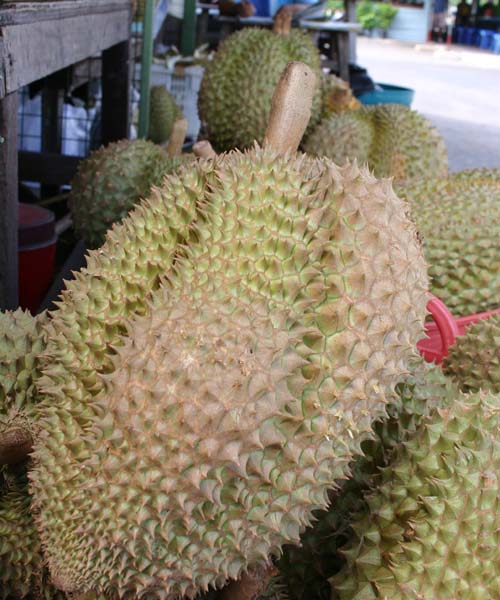
The big and spiny durian.
No discussion of Thai fruits can be complete without the durian. This odd fruit is like truffles to the French, or perhaps haggis to the Scots would be a more apt comparison, since it is hard to think of a more objectionable edible product. Although there are many varieties, most durians are larger than an adult's head and covered with very sharp spikes about an inch long.
Within the thick skin are usually five seed pods consisting of a thick gooey mucous which surrounds a seed the size of a chestnut. The mucous is the edible part. In texture, and even in taste, the closest comparison I can think of is marshmallows. The fruit is thought to have originated in the islands of Indonesia.
The Dutch who occupied and colonized much these islands called the fruit stinkvrucht due to its terrible odor. The smell is so bad that many people can't get past it. When I tell Thais that I'm not fond of durian, they assume it's because of the smell, but in fact I find the "golden pillow" (mon tong) variety favored by Thais much too sweet for my taste.
But such is the love of durian throughout South-east Asia that Thailand exports several tonnes of the fruit to other countries within the region during the season, which runs from about March to July. The country's national carrier has even in some years run special cargo flights shipping entire plane-loads of durian to Hong Kong and other destinations, where people eagerly stuff themselves with the stinky fruit.
Durian does have a dangerous side, the sulphur-rich chemical soup that gives the fruit its foul odor also reacts strongly with alcohol. You may feel the need for a stiff drink before trying durian for the first time, but you must avoid it at all costs. The reaction between these two can lead to death if too much of either is consumed.
During their season, which runs from around March to September, durians can be found in most markets all around the country. In addition to a poor sense of smell, the other basic tools needed by durian sellers are a pair of thick leather gloves and a stick. The gloves protect the hands from the sharp spikes, while the stick is used to 'test' the durian. Believe it or not, the way to tell a 'good' durian from a 'bad' one is not by smell, but by how it sounds. 'Good' durians will make a hollow sound when whacked with a stick. No self respecting Thai would buy a durian without hearing how it sounds first.
Once they've found the right fruit, the vendor will weight it to set the price. The most valuable golden pillow variety sells for around 50 U.S. cents a kilogram. While that may sound inexpensive, the whole fruit is quite heavy and may weigh more than five kilograms, yet yield less than a kilogram of edible product. After the purchase, there's just one more challenge: how to carry a fruit that will easily shred the thin plastic bags used to pack most other fruits in the market? In most cases, the vendor will cut open the fruits and remove the seed seed pods for the customer, who is happy to leave the spiny husk behind. Some vendors will even sell the individual pods for customers who don't want or can't afford a whole fruit.